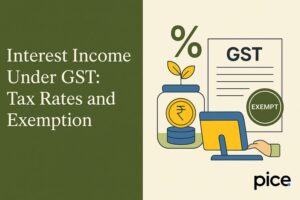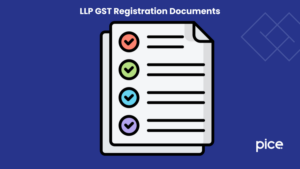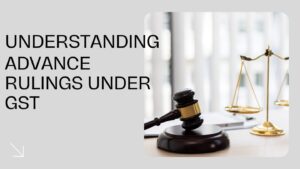GSTR 9 Tables Analysis: Mandatory & Optional Tables
- 19 May 25
- 16 mins
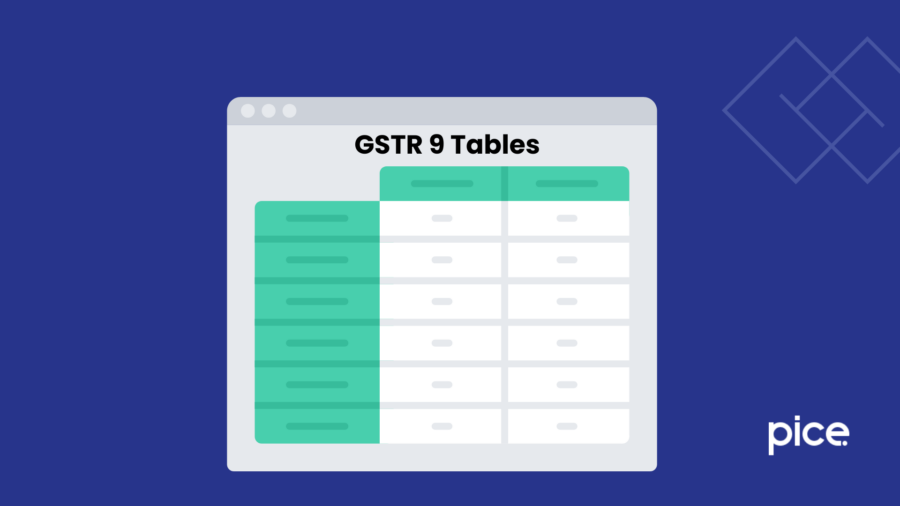
GSTR 9 Tables Analysis: Mandatory & Optional Tables
Key Takeaways
- GSTR-9 is a mandatory annual GST return for taxpayers with turnover exceeding ₹2 crore, due by 31st December following the financial year.
- It comprises 6 parts and 19 sections, consolidating sales, purchases, ITC, tax payments, and adjustments across the year.
- Table 4 and Table 6 are crucial, capturing all taxable outward supplies and ITC availed during the year respectively.
- Accurate reporting in auto-populated and manually filled tables ensures compliance and avoids reconciliation mismatches.
- Optional tables like Table 5, 7, 12, 13, 15, and 17 aid in complete disclosures but are not mandatory for all taxpayers.
GSTR-9 form is an annual GST return that must be filed by 31st December of the year following the relevant financial year. For instance, the due date for filing this form for FY 2024-25 is 31st December, 2025.
Registered taxpayers with an annual turnover exceeding ₹2 crore are required to file it, as per the threshold set by the GST department each year. This form is divided into 6 parts and 19 sections, covering consolidated details of sales, purchases and GST paid or charged throughout the financial year.
These details to be filled in GSTR-9 tables are easily accessible from the returns files previously or books of accounts.
Mandatory Tables in GSTR-9 Annual Return
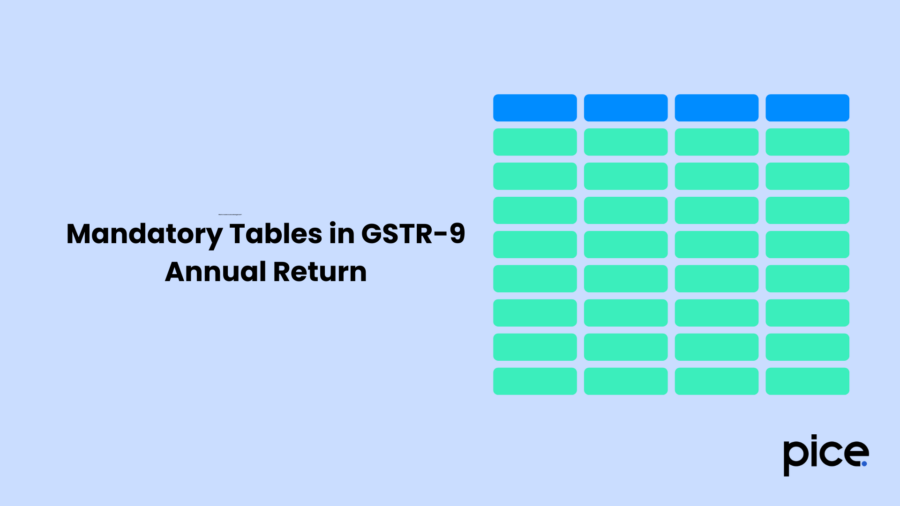
Here are the mandatory tables that must be filled by all eligible taxpayers to ensure accurate reporting of GST transactions in a financial year. Take a look:
GSTR-9 Table 4: Details of Advances, Inward and Outward Supplies Made During the Financial Year, Which Are Subject to Tax Payment
Table 4 covers all supplies for which the taxpayer is responsible for paying GST during the financial year. Taxpayers should ensure that values are entered with up to two decimal places in the GSTR-9 offline utility. Reporting values with three decimal places may result in the "Error! Invalid Summary payload" message when uploading the JSON generated from the utility.
| Table 4 | Nature of Supplies | Details to be Filled in |
| A | Supplies made to unregistered persons (B2C) | The total value of inter-state supplies made to consumers and unregistered individuals, on which tax has been paid, must be reported here. This includes supplies made via e-commerce operators and should be declared after accounting for any credit or debit notes. Note: To fill in these details, refer to Tables 5 and 7, along with the relevant amendments in Tables 9 and 10 of Form GSTR-1, as amended by Form GSTR-1A. |
| B | Supplies made to registered persons (B2B) | The aggregate value of inter and intra-state supplies made to registered persons (including UINs) on which tax has been paid must be reported here. This includes supplies made via ecommerce operators but excludes supplies where tax is paid by the recipient under the reverse charge provisions. Details of credit and debit notes should be entered separately in 4I and 4J below. Note: Refer to Tables 4A and Table 4B of Form GSTR-1, as amended by Form GSTR-1A for filling in these details. |
| C | Zero-rated supply (export) on payment of tax (except supplies to SEZ) | The aggregate value of exports on which tax has been paid should be reported here, excluding supplies to SEZs. Note: To fill in these details, go through Table 6A of Form GSTR-1, as amended by Form GSTR-1A. |
| D | Supplies to SEZ on payment of tax | The total value of supplies to SEZs on payment of tax should be reported here. Note: For this, refer to Table 6B of Form GSTR-1. |
| E | Deemed exports | The aggregate value of supplies classified as deemed exports on which tax has been paid should be reported here. Note: Use Table 6C of Form GSTR-1, as amended by Form GSTR-1A, to fill in these details. |
| F | Advances on which tax has been paid but the invoice has not been issued (not covered under (A) to (E) above) | Details of all unadjusted advances, i.e., advances towards supply and tax paid but no invoice has been issued in the current financial year, should be reported here. Note: Use Table 11A of Form GSTR-1, as amended by Form GSTR-1A, to enter these details. |
| G | Inward supplies on which tax is to be paid on the reverse charge basis | The aggregate value of all inward supplies (including advances and net of credit and debit notes) on which the recipient (i.e., the taxable person filing the annual return) is liable to pay tax on a reverse charge basis should be reported here. This includes supplies received from both registered and unregistered persons where tax is applicable under the reverse charge mechanism, as well as the aggregate value of imports of services. Note: Refer to Table 3.1(d) of Form GSTR-3B for entering these details. |
| G1 | Supplies on which the e-commerce operator is required to pay tax as per Section 9(5) (including amendments, if any) [To be reported by E-commerce operator] | The aggregate value of all supplies (net of amendments) on which tax is to be paid by e-commerce operators under Section 9(5) must be reported by the e-commerce operator. Note: For filling in these details, refer to Tables 15 and 15A of Form GSTR-1. |
| H | Sub-total (A to G above) | Here goes the sub-total of (A) to (G) rows. It gets auto-populated. |
| I | Credit notes issued in respect of transactions specified in (B) to (E) above (-) | The aggregate value of credit notes issued for B2B supplies, exports, supplies made to an SEZ and deemed exports should be declared here. Note: For filling in these details, refer to Table 9B of Form GSTR-1 as amended by Form GSTR-1A. |
| J | Debit notes issued in respect of transactions specified in (B) to (E) above (+) | The aggregate value of debit notes issued for B2B supplies, exports, supplies made to an SEZ, and deemed exports should be declared here. Note: For filling in these details, refer to Table 9B of Form GSTR-1 as amended by Form GSTR-1A. |
| K/L | Supplies/tax declared/reduced through amendments (+) | Details of any amendments made to B2B supplies, exports, supplies to an SEZ, deemed exports, credit notes, debit notes and refund vouchers should be declared here. Note: For filling in these details, refer to Tables 9A and 9C of Form GSTR-1 as amended by Form GSTR-1A. |
| M | Sub-total (I to L above) | Here goes the subtotal of rows (I) to (L) given above. It gets auto-populated. |
| N | Supplies and advances on which tax is to be paid (H + M) above | This row is auto-populated and is a sum-total of rows (H) + (M) |
GSTR-9 Table 6: Details of ITC Availed During the Financial Year
This section details the input tax credit claimed during the year, categorised by inward supplies from registered and unregistered persons, reverse charge transactions and imports of goods or services.
| Table 6 | Name | Details of Table |
| A | Total amount of Input tax credit availed through Form GSTR-3B. | The details of ITC availed from Table 4A of GSTR-3B are auto-populated in this table and cannot be edited. |
| B | Inward Supplies (other than imports and inward supplies liable to reverse charge but includes services received from SEZs) | This table requires the classification of ITC claimed on all inward supplies, excluding imports and those subject to reverse charge, but including services received from SEZ, into Input, Capital Goods and Services. For reference, Table 4(A)(5) of Form GSTR-3B can be used to fill in these details.Note: The taxpayer must provide a breakup of ITC as capital goods. They have the option to either classify the remaining amount as inputs and input services or report the entire remaining amount under the “inputs” category. |
| C & D | Inward Supplies liable to reverse charge on which tax is paid and ITC availed 6C: Received from unregistered persons (other than the import of services)6D: Received from registered persons | The aggregate value of input tax credit (ITC) on all inward supplies should be reported in the following tables:6C: Supplies received from unregistered persons liable to reverse charge (excluding import of services)6D: Supplies received from GST-registered taxpayerNote: The ITC must be further categorized into input, input services and capital goods.For reference, Table 4(A)(3) of Form GSTR-3B may be used to fill in these details.The taxpayer has the option to either report Tables 6C and 6D separately or combine the details of both tables and report them under Table 6D only. |
| E | Import of goods (including supplies from SEZ) | The aggregate value of ITC availed on all imports from outside India or SEZ units should be reported in this table.Note: Table 4(A)(1) of Form GSTR-3B can be referred to for filling in these details.If goods are supplied by an SEZ to a DTA without a bill of entry, it is considered a normal transaction and should not be reported in this table.The ITC should be further categorized into inputs and capital goods. |
| F | Import of services (excluding inward supplies from SEZs) | The aggregate value of ITC availed on all import services from outside India should be reported in this table.Note: For a transaction to qualify as an import of service, the place of supply of the service must be within India.Table 4(A)(2) of Form GSTR-3B can be referred to for filling in these details. |
| G | Input Tax credit received from ISD | The aggregate value of ITC availed on invoice level raised by the Input Service Distributor (ISD) should be reported in this table.Note: The details will perhaps get auto-populated from Table 4(A)(4) of GSTR-3B. |
| H | Amount of ITC reclaimed | The aggregate value of ITC that was availed, reversed, and subsequently reclaimed during the same financial year should be reported in this table. |
| I | Sub-total (B to H above) | It is a sub-total of 6B to 6H. This gets auto-populated. |
| J | Difference (I – A above) | It is calculated as the difference between rows I and A. Ideally, this difference should be NIL as the data in row 6A is auto-populated from GSTR-3B and Tables 6B to 6H simply classify the ITC availed in GSTR-3B into inputs, input services and capital goods. |
| K, L & M | Transitional and other input tax credits | Table 6K: The amount of transition credit received in the electronic credit ledger via TRAN-I must be reported here. |
| Table 6L: The amount of credit received in the electronic credit ledger via TRAN-II should be reported here. | ||
| Table 6M: Details of ITC availed but not included in any of the categories specified in rows B to L above must be declared here. This includes ITC availed through Form ITC-01 and Form ITC-02 during the financial year. | ||
| N | Sub-total (K to M above) | It is the subtotal of rows K to M. It gets auto-populated. |
| O | Total ITC availed (I + N above) | Total ITC availed is reported here which is a total of rows I and N. |
GSTR-9 Table 8: Other ITC Related Information
The GSTR-9 online form, accessible via the official GST portal, is now updated with a button titled ‘Download Table 8A Document Details’. So now, GSTR-9 filers can easily avail invoice-wise details of the input tax credit, which gets auto-populated in Table 8A of the GSTR-9 return.
| Table 8 | Name | Details |
| A | ITC as per GSTR-2B | The total credit available for inward supplies, excluding the imports and inward supplies subject to reverse charge but including services received from SEZs and E-commerce operators, with respect to the financial year and as reflected in 3(I) of Form GSTR-2B will auto-populate here. The same cannot be edited. Note: This particular table (Table 8A) is the most important table when it comes to ITC reconciliation for a financial year. Here all the figures will be the aggregate of all the input tax credits declared by the corresponding suppliers, including E-commerce operators, in Form GSTR-1 as amended by Form GSTR-1A. |
| B | ITC as per sum total of 6(B) and 6(H) above | The input tax credit reported in Tables 6B and 6H will be auto-populated here. |
| C | ITC on inward supplies (excluding imports and those under reverse charge but including services from an SEZ) received in 2024-25 yet claimed between April and October 2025, with filings due by 30th November 2025. | Data can be derived from Table 4(A)(5) of GSTR-3B. This table also covers services received from SEZs. |
| D | Difference [A-(B+C)] | This table represents the difference between row (A) and the total of rows (B) and (C). However, if the ITC availed in FORM GSTR-3B exceeds the credit available in FORM GSTR-2A/2B, the value in row (D) will be negative. |
| E & F | ITC available but not availed & ITC available but ineligible | The credit available but not claimed in Form GSTR-3B, along with the ineligible credit not availed, should be reported here. Ideally, if 8D is positive, the total of 8E and 8F should match 8D. |
| G | IGST paid on import of goods (including supplies from SEZ) | Here comes the IGST payable at the time of imports (including imports from SEZs) during a financial year. |
| H | IGST credit availed on import of goods (as per 6E above) | This table will be auto-populated from Table 6(E). |
| I | Difference (G-H) | This table is a difference between rows G and H above. |
| J | ITC available but not availed on import of goods | Details will come from row I above. |
| K | Total ITC to be lapsed in the current financial year (E + F + J) | This table is a sum-total of rows E, F, and J above. |
GSTR-9 Table 10 & 11: Adjustments for the Previous Year
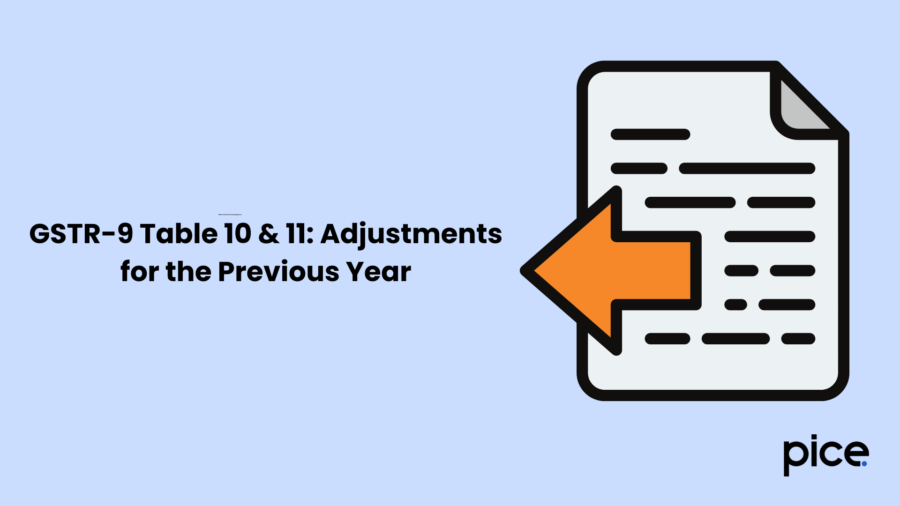
In Table 10-11, details of transactions from the previous financial year must be reported if tax was paid through Form GSTR-3B.
For FY 2023-24, transactions reported between April 2024 and October 2024, with filings completed by 30th November 2024, should be disclosed as per CGST Notification No. 12/2024 – Central Tax, dated 10th July 2024.
| Table | Nature of Supplies | Details to be Filled-in |
| 10/11 | Supplies/tax declared/reduced through Amendments (net of debit/credit notes) | Any additions or amendments to supplies already reported in the previous financial year's returns, but later updated in Table 9A, Table 9B and Table 9C of FORM GSTR-1 between April 2024 and October 2024, with filings completed by 30th November 2024, should be reported here. |
Optional Tables in GSTR-9 Annual Return Forms
While not mandatory, filling out the tables outlined below can help in the accurate reporting of ITC claims and tax adjustments. Take a look:
GSTR-9 Table 5: Details of Outward Supplies Made During the Financial Year on Which Tax is Not Payable
Table 5 contains information about supplies on which no tax is payable or which are exempt under GST.
| Table | Details |
| Table 5A | Zero rated supply (export) without payment of tax |
|---|---|
| Table 5B | Supply to SEZ without payment of tax |
| Table 5C | Supplies on which tax is to be paid by the recipient on reverse charge basis |
| Table 5D | Exempt Supplies |
| Table 5E | Nil Rated Supply |
| Table 5F | Non-GST supply |
GSTR-9 Table 7: Details of ITC Reversed and Ineligible ITC for the Financial Year
The registered person can choose to enter reversal details separately in Table 7A to 7E or report the total reversal amount in Table 7H. However, reversals related to TRAN-1 (Table 7F) and TRAN-2 (Table 7G) must be reported mandatorily.
GSTR-9 Tables 12 and 13: Details of the Previous Financial Year’s Transactions Reported in the Next Financial Year
This section records ITC claims that were reversed or availed after the financial year ended but before the filing deadline. It is optional for taxpayers with minimal adjustments.
| Table | Name | Details |
| Table 12 | Reversal of ITC availed during the previous financial year | The aggregate ITC pertaining to FY 2023-24, which was reversed in GSTR-3B returns filed between April and October 2024 or by the annual return filing deadline, whichever comes first, should be reported.You can refer to Table 4(B) of Form GSTR-3B for these details. |
| Table 13 | ITC availed for the previous financial year | Report the ITC related to FY 2023-24 that was claimed in GSTR-3B returns filed between April and October 2024, or by the annual return filing date, whichever occurs earlier.For these details, refer to Table 4(A) of Form GSTR-3B.Additionally, any ITC reversed in FY 2023-24 under the second provisio to subsection (2) of section 16, but later reclaimed in FY 2024-25, should be reported in the annual returns for FY 2024-25. |
GSTR-9 Table 15: Refunds and Demands
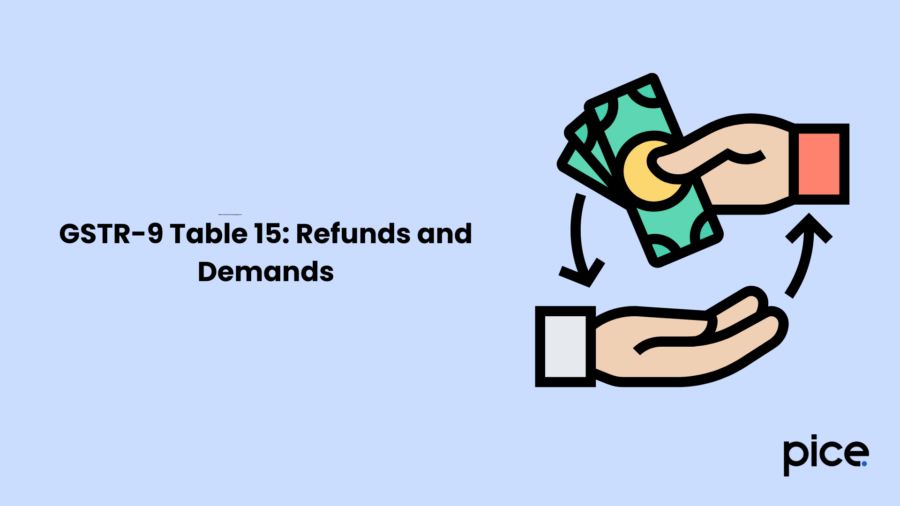
This table provides details on refunds claimed and demands raised during the financial year. While completing this table is optional, it is useful for comprehensive reconciliations.
GSTR-9 Table 16: Miscellaneous
This section includes details on supplies received from composition taxpayers, deemed supplies and goods sent on an approval basis. Businesses with few or no such transactions may omit this section.
GSTR-9 Tables 17 & 18: HSN Wise Summary
This section summarises outward and inward supplies according to the HSN code. It is optional for smaller taxpayers to help reduce compliance burdens.
Conclusion
In GSTR-9 tables, taxpayers must report all outward and inward supplies, taxes paid, refunds claimed, demands raised and ITC availed or utilized in a financial year. Ensuring accuracy and completeness in annual GST returns is crucial for business compliance. Whether a table is mandatory or optional, errors in filing can lead to penalties, audits and unnecessary scrutiny.
💡If you want to streamline your invoices and make payments via credit or debit card or UPI, consider using the PICE App. Explore the PICE App today and take your business to new heights.
 By
By 








